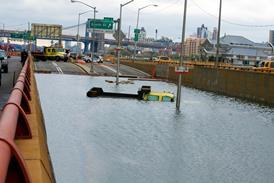As with all decisions arrived at by the committee process, the end result bears little resemblance to the role model aimed for at the outset, the trouble is that we (the installers) have to live with it. For most installers the new standard is viewed with a lot of mistrust, even contempt, and I hear a lot of comments like "Well, I don't care what they say – I'm not dropping my standards for any foreigner", or "It's nothing but a rogue's charter that will put us out of business".
Just recently, as you would expect in my "day job" as an inspector, the new standards, and how we are going to cope with them, have been discussed at length . As my illustrious leader pointed out, the first part of coping is to understand what the new standards are about and where they are coming from, and, after much scepticism, I finally have to admit that there is a lot of sense in the new standards and I can now see a lot of good coming out of them. Let's start by dispelling a few misunderstandings.
Class of four
There are four classes of system and they have been graded in risk levels, Class One being the lowest, Class Four the highest. For example – a domestic property in a low crime area (Class One) is unlikely to attract the professional thief who can disable an alarm system, so it was deemed to be unnecessary to fit tamper circuits to the detectors.
Not fitting tamper circuits turns out to be quite abhorrent to most of you, hence the reasoning that you are going to have to lower your standards. Well, good for you! Ten out of ten for following your instincts. Now, let's look at reality. Just because tamper circuits are not a requirement (in Class One only) it doesn't mean that you are forced to leave them out. If you feel better installing them then go ahead. You will get much praise and commendation for it (no money – just praise and commendation). On the other hand, if the domestic customer wants you to "slice the price" to compete with the cowboys, this and a few other things can now be "legally" cut, giving you the opportunity to go for the throats of the guys that have been undercutting you for years by fitting what we consider to be sub-standard systems.
It's the same story with bell boxes. We now have a variety of options and one of those is to do away with the SAB unit by fitting a second sounding bell box. The word to remember is "option". No one is forcing you to dispense with the SAB if you feel that strongly about it.
'Pond life' option
On the other hand, there may be some mileage to be had out of it by explaining to the customer that only the "pond life" installer would fit such a low level of security and that you (in their best interests) would much prefer to fit the higher levels of system – "a bit more expensive but well worth the extra"!
I have to concede that there is some good to come out of the new Euro-Standard once we get our heads round it; it just leaves you to learn how to sell it. One of the questions often asked is "how soon will I have to start fitting to the new standards"? At the moment I can't give a positive answer because they haven't finished writing them yet, the respective committees are still ensconced in their committee rooms, ties loosened, sleeves rolled up, arguing out the final details. I think we owe them all a round of applause because it is a soul destroying job trying to find that elusive formulae that is acceptable to all men in all countries – a near impossible task.
When standards overlap
They did however, a couple of years back, launch on the unsuspecting public the results of their work so far – BS EN 50131 part 1, the "General Requirements". Since the much-publicised launch, it has sat on the sidelines with half the trade not wanting to touch it with a sterilised barge pole and the other half pretending it doesn't exist. Now, however, it has had a distinct push forward by the BS people themselves and they have published an "enabling document" in the form of PD 6662.
It is quite simple really. Some bright-eyed body has noticed that BS EN 50131 and BS 4737 actually fit neatly together. 50131 tells us what we need to fit (the number and types of sounders and the types of detection and signalling etc) for each class of system and 4737 tells us how it should be fitted.
All we need to know now is which way to jump when there is a slight contradicting overlap between the two standards, and that is the aim of PD 6662 – to straighten out the contradictions and give us the go-ahead to start working to the new standards.
Whether it was intentional or not I don't know, but it has given the insurance companies a heaven sent opportunity to wear out the seats of their pants instead of their shoe leather by "quoting from the desk". Until now, to ensure reasonable and adequate coverage of a property, an insurance company would send out a surveyor who would survey the property and make up a list of security requirements before they would "sign the pledge" so to speak. It prevented the less scrupulous among us from cutting levels of coverage to get the price down (quite acceptable within 4737, provided you can get the customer to sign his life away), win the job and let the insurance people cough up when the thieves found the gaps in our "price revised" installations.
Insurance on the the phone
Choose the inspectorate you think will suit you best and hop on the bandwagon
With the onset of a standard that actually gives minimum requirements of cover, the insurance people can now "do it on the phone". All they have to do is ask the type of business being carried out, the monetary values of the stocks carried and the postcode of the property. According to theory, they now have all the info they need to consult the risk chart. The risk chart will cross reference the nature of the trade or business with the postcode and the stock levels in cash value and come up with a minimum class level for insurance purposes. They are then at liberty to specify, for example, a Class 2 system, at this point they may decide to add that it has to be installed by a "Class 2" company and this is where the inspectorates come in.
ACPO are now demanding that all inspectorates should be UKAS accredited, so the inspectorates are currently beavering away to get that accreditation. Once gained, it will give the inspectorates the ability to officially grade or accredit the installation companies accordingly into whatever class or level they fall.
It's a bit like the ISO 9000 people, if you want to get ISO 9000 you can't just get any old Tom Dick or Harry off the street corner to give it to you, you have to have a company that is suitably qualified or "accredited".
The question then is who accredits the accredited? In this case it's UKAS (United Kingdom Accreditation Services). They are the inspectorate that will inspect the inspectorates … and if you think that's confusing, try being the piggy in the middle who has to sort that little lot out. It's a king sized pain in the nether regions.
The uncertain factor at the moment is: Just what qualifications or requirements would an installing company need to get which class of recognition? It could well be an excellent opportunity for the insurance companies to get together with the inspectorates and ACPO to set the levels required. For example, every inspectorate company would be a "Class 1" installer capable of installing domestic and low risk commercial systems.To move up to Class 2, the requirement may be two suitably vetted engineers, one of which has a qualification of some sort. They can then install systems of a higher risk level that may well include police response.
Moving on up
To move up to Class 3, the requirement may be a few more engineers, all vetted to BS 7858, a separate office away from the domestic situation and possibly ISO 9002. The Class 4 would be those company capable of installing at banks etc. (Please don't quote me on the above levels. They are only my guesses to help explain things. We have yet to see if the insurance companies pick up that particular ball and run with it.). There's another factor to take into consideration – physical security. If the insurance companies decide to go the route of sitting on their bums and letting you, the installer, do the legwork (it's called leaving it to the experts), they may decide to include locks and keys in the equation. For a lot of installers that means calling in the cavalry, better known as "Keyhole Ken" the local locksmith.
Quote for physical too
As you will know if your read the article in last month's Installer, physical and electronic security really do go hand in hand. So, if the Insurance companies are intending to specify from the desk, you may well see a specification that says "A Class 3 electronic security system shall be installed by a Class 3 recognised company and the building should have physical security to the levels as laid down in BS 8220 part two"
For the insurance man it makes life a whole load easier but it means that we have to get the job right or risk taking a kicking on our wrongful advice insurance. That's another point – are we covered to give lock and key advice on our alarm installer's policy?
My advice is to start looking into the matter before you start losing out to the opposition. On the other hand, we have to go out and quote anyway – so little is lost by quoting the physical stuff whilst there, maybe much to gain.
There is one last but very important point that emerges from all this. It's a bit complicated but here goes: With the onset of PD 6662 and the new working relationship between the old and new published standards, and the grading of installing companies by the inspectorates (under the watchful eye of UKAS), and the possible added responsibility of organising (if not actually fitting) physical security, and finally the possible licensing of security installers as suggested by the government White Paper, does it mean that our industry will quite soon become much more 'insurance driven'? In some respects this could be a good thing, the insurance companies now have an excellent opportunity to get rid of all the cowboys and undesirable characters that populate our industry, simply by specifying the class of system and the class of installer and asking for proof of recognition.
I know that this will seem like a slap in the face for all the many good installers out there that choose NOT to belong to an inspectorate and NOT be regulated. But, you have to look at it from the insurance company's point of view: you may be an excellent installer or you may be a first class rip-off merchant.
The public have little, or no, idea and the insurance companies only a vague idea.
Insurers can only fall back on the inspectorates and/or licensing to sort out the good from the bad, and if you're not "legit" you are out on your ear.
Source
Security Installer
Postscript
Mike Lynskey is an independent inspector of security systems, a security consultant and tutor. You can email him at mike.lynskey@virgin.net





















No comments yet